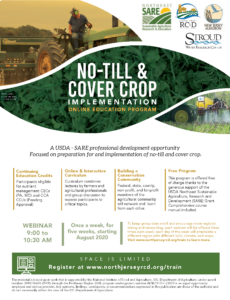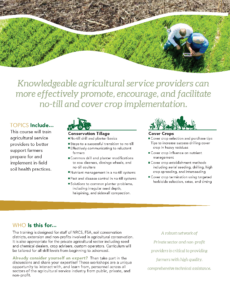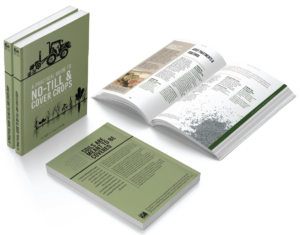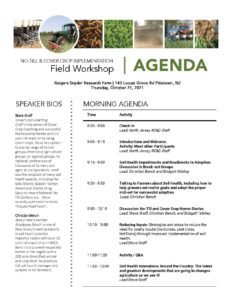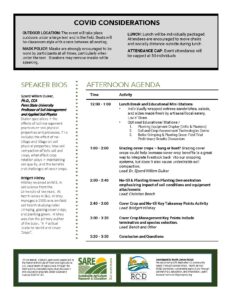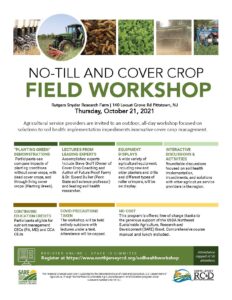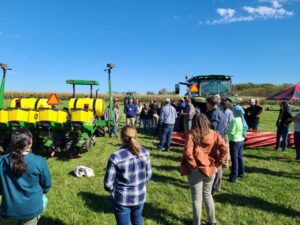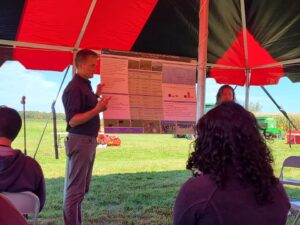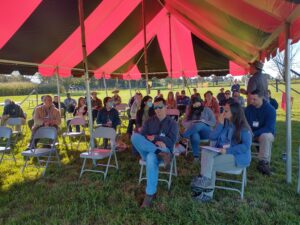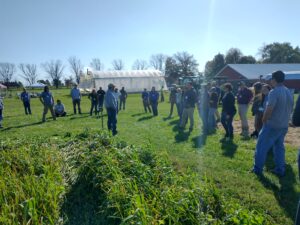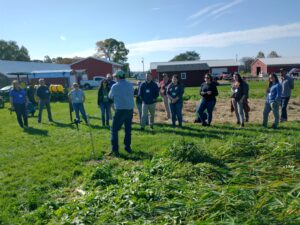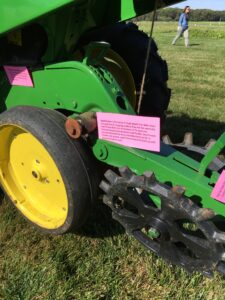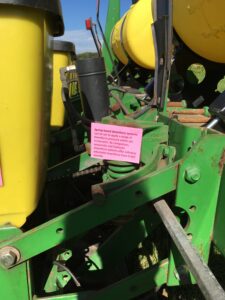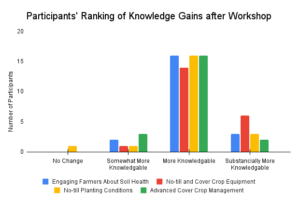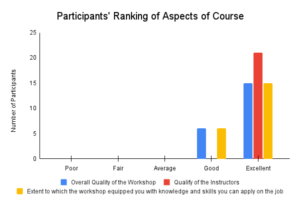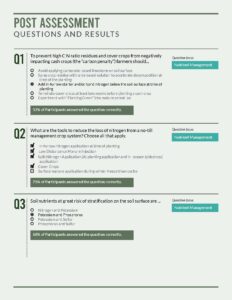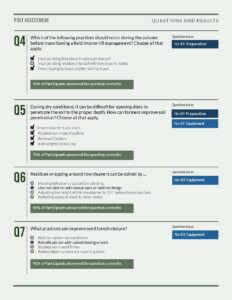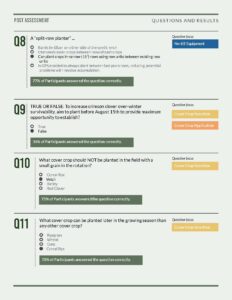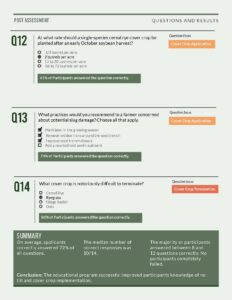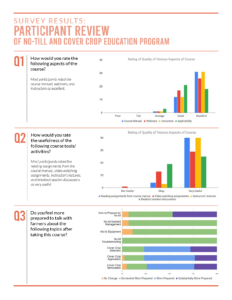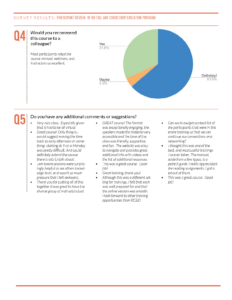Final report for ENE19-157
Project Information
PROBLEM AND JUSTIFICATION: The agricultural community widely recognizes no-till and cover crop practices as beneficial to soil health and long-term farm sustainability. However, the transition to no-till and cover crop farm systems can be difficult and demands acquiring a significant amount of knowledge, skill, and equipment to ensure success. Many agricultural service providers (ASPs) do not possess the necessary expertise or resources to assist farmers with implementation decisions. Furthermore, digital and print educational resources available to northeastern commodity crop farmers do not provide concise, practical instructions. Thus, the onus is on the producer to research practice implementation -- often a time-consuming and overwhelming task. Knowledge barriers prevent the widespread adoption of soil health practices that enhance farm productivity and promote resilience while protecting water quality.
EDUCATION APPROACH AND PRODUCTS: North Jersey RC&D created a five-part, interactive, webinar training series emphasizing no-till and cover crop implementation that will train agricultural service providers to better support farmers who are preparing for and implementing in-field soil health practices. Webinars occurred once a week for five weeks during August and early September 2020 from 9:00 to 10:30 AM. To keep group sizes small and encourage a more regional dialog, each workshop was offered three times each week. Each day of the week emphasized a different region with different soils, climates, and crops. The overarching goal was to develop an interactive curriculum that combined short presentations by farmers and agricultural professionals with short activities and small group discussions to expose participants to critical topics.
Recognizing that no-till and cover crop implementation was too complex to teach in a series of short webinars, NJRCD created a comprehensive course manual. In this way, the course could function more like a college course, with participants reading and learning material at home before lectures. The 180-page manual, entitled “A Practical Guide to No-till and Cover Crops in the Mid-Atlantic,” was created in collaboration with local farmers, agronomists, and ASPs. These books serve as an enduring educational resource for the ASP and farming communities.
In the fall of 2021, NJRCD invited project participants to a No-till and Cover Crop Field workshop at Rutgers Snyder Research Farm. The field day was designed to re-engage program participants and provide an opportunity to interact with no-till and cover crop implementation equipment. The event included lectures from leading experts, an in-field planting demonstration and roller crimping demonstration, an equipment display, and small group discussions.
SERVICE PROVIDER LEARNING OUTCOMES AND ACTIVITIES: 90% or more of program participants stated they felt more prepared to talk with farmers about (1) How to Prepare for No-till, (2) No-till and Nutrient Management, (3) No-till Equipment, (3) No-till Troubleshooting, (4) Cover Crop Selection, (5) Cover Crop Application, and (6) Cover Crop Termination. 32 ASPs in the program reported using the knowledge and skills obtained to assist 210 farmers across 31,148 acres. Additionally, ASPs incorporated information from the course in 34 educational activities, services, and information products.
100 agricultural service providers (ASPs) who increase knowledge related to specific techniques and challenges associated with planting cover crops and adopting no-till in commodity crop systems, will provide comprehensive technical assistance to 600 farmers, operating 60,000 acres of cropland, regarding transitioning to no-till and implementing cover crops.
Within the Delaware River Basin, 7200 farmers cultivate corn and soybeans on over one million acres. As a consequence of current land management practices, 75% of cropped acres are losing soil organic carbon every year, and 51% of cropped acres have “a high-level need for additional conservation treatment” (NRCS 2014).
Transitioning to no-till and implementing cover crop are among the most cost-effective tools to reverse soil carbon loss and improve soil health (Zhou et al. 2009); the economic, agronomic and environmental benefits of these practices are well known within the farming community, and many non-users have considered no-till and cover crop implementation (Arbuckle and Ferrell 2012; CTIC 2017). However, transitioning from conventional farming to no-till and cover crops is complicated and demands a substantial investment in time to learn the information necessary to succeed. Farmers face hurdles including field soil preparation, equipment purchasing decisions, and impacts on agronomic practices. Google search data demonstrates that farmers are trying to learn about practice implementation; terms “how to plant cover crop”, “row cleaner”, “closing wheel”, and “no-till coulter” are three to twenty-four times more popular than the search terms “cover crop species” and “cover crop benefits”, topics which receive greater attention by ASPs. For many farmers, lack of knowledge is a barrier to implementation (Arbuckle and Ferrell 2012; Kitchen et al. 2002; McRobert and Rickards 2010)
Many agricultural service providers (ASPs) cannot meet the farmer’s need for technical assistance (NFWF 2017). In a survey of Delaware River Basin ASPs, less than half could identify no-till equipment and even fewer could answer basic questions regarding cover crop establishment and termination methods. ASPs who do not fully understand the practices they promote, cannot effectively encourage farmers to adopt conservation practices nor assist farmers with the transition process. Reliance on accessible, high-quality technical assistance is an essential component of successful modern-day, sustainable agriculture. Among farmers seeking assistance from ASPs, the knowledge gap discourages not only cover crop and no-till implementation but also contributes to the lack to trust between ASPs and farmers.
Existing print and digital resources do not meet the needs of farmers. They tend to heavily emphasize soil health, species comparisons, and research results. Resources lack precise instructions and equipment configuration recommendations. The excess information can lead farmers to become overwhelmed with options. Farmers often rely on blogs and hearsay for advice regarding drills, planters, coulters, interseeders, row cleaners, closing wheels, etc.
North Jersey RC&D created an education program, serving ASPs throughout the Delaware River Basin, that trained ASPs to more effectively promote, encourage and facilitate no-till and cover crop implementation. This project engaged ASPs, including extension agents, NRCS, FSA, soil conservation districts, crop consultants and others, in a comprehensive education program that focused on preparation for and implementation of no-till and cover crops.
To encourage subject mastery, a three-step approach was used: teach, review, apply. ASPs took part in a five-week No-till and Cover Crop Implementation online education program (Summer 2020). To keep group sizes small and encourage a more regional dialog, each workshop was offered three times each week. The project coordinator measured changes in participants’ knowledge and skills as a result of project participation, and tracked participants’ delivery of technical assistance to farmers and farmer’s subsequent actions. The optional fall 2021 field workshop was highly interactive: participants were challenged to ask questions, interact in discussions, and problem solve.
A network of educated and knowledgeable ASPs are now available to support farmers' transition to no-till and cover cropping and reduce the knowledge barrier that discourages implementation. Access to well-informed ASPs and succinct unbiased education materials simplify the transition process, reduce uncertainty, and increase the likelihood of farmer success.
Cooperators
- (Educator)
Educational Approach
The curriculum was guided by the participant’s existing knowledge and advisory board insights. To encourage subject mastery, the project used a three-step approach to education: teach, review, apply. Cover crop implementation will be introduced during a two-hour webinar (March 2020) and reviewed during a one-day field-based workshop (April 2020). Steps to successful no-till transition will be introduced during a webinar (August 2020) and reviewed during a one-day field-based workshop (September 2020). COVID REVISION: ASPs took part in a five-week No-till and Cover Crop Implementation online education program (Summer 2020). Participants, divided into three regional cohorts, were introduced to complex topics through at-home assignments which included reading chapters of the course manual and watching select videos. During 1.5-hour webinars, topics were reviewed and elaborated upon through experiences and discussions guided by leading experts. Webinars were designed to be highly interactive and used video and images to teach cover crop application methods, rates, species, and termination solutions.
COVID REVISION: ASPs were also invited to a 100% outdoor field day when COVID rates were lower. The field event took place approximately 1 year after the webinars and was an opportunity to showcase no-till equipment, cover crop establishment, and advanced no-till and cover crop practices. Participants were challenged to ask questions, interact in discussions, and problem solve.
After completing coursework, ASPs are able to answer the most common questions posed by commodity crop farmers beginning no-till and cover-cropping. Specifically, the program educated farmers regarding steps a farmer takes and the choices and decisions made when adopting no-till and cover crops and provide them with the necessary information to be a useful information source to farmers.
** All revisions made in response to COVID, will be italics.
Milestones
PROJECT RECRUITMENT:
200 ASPs in the Delaware River Basin (NY, PA, DE, and NJ) receive recruitment invitations to participate in the education program through targeted phone-calls, emails, flyers, and message boards. Fall 2019
200
250
November 30, 2019
Completed
July 15, 2020
Although we had initially planned to conduct one training in the fall of 2019 and a second training in the spring of 2020, during meetings and conversations with the project advisory team, there was overwhelming agreement that both ASP training events should take place in late summer and early fall. As a result, we delayed participant recruitment until the spring of 2020.
As the COVID pandemic began to take form, NJRCD made the decision to move all training online. During the summer of 2020, NJRCD and project partners (NJ Audubon and Stroud Water Research Center) outreached, via email and social media, to New Jersey, New York, Pennsylvania, and Maryland NRCS, Soil Conservation District, Extension, and agricultural non-profit and for-profit staff. NJRCD created a course website (https://www.northjerseyrcd.org/train) and a flyer (Training Flyer) that was used to assist in the promotion of the program.
To broaden program value, NJRCD worked closely with staff at the Maryland Department of Agriculture and Penn State Extension to offer continuing education nutrient management credits to program participants for participation in zoom-based webinars AND completion of at-home assignments/reading. In addition, NJRCD worked with the Certified Crop Advisor organization to offer Continuing Education Units to program participants. By offering credits, the education program was listed/advertised through each of the respective organization's websites and the appeal was broader to include seasoned professionals with multiple years of experience. This ensures a diverse mixture of beginners and experts were enrolled in the online education program.
NJRCD individually emailed 75+ individuals and presented information about the course at the following venues:
- New Jersey State NRCS Technical Advisory Committee Meeting (70+ ASP Attendees)
- National Fish and Wildlife Foundation Agricultural Roundtable (40+ ASP Attendees)
- NJ NRCS Weekly Newsletter (200+ ASP Viewers)
- Delaware River Watershed Initiative Agricultural Network Basecamp Email Group (50+ Viewers)
- PA Nutrient Management Couse Calendar (Viewers Unknown)
- Certified Crop Advisors Continuing Education Credit Couse Calendar (Viewers Unknown)
The course website (https://www.northjerseyrcd.org/train) received 446 views from 416 unique visitors during the primary sign-up period (June 2020 through August (2020).
120 ASPs will apply online to participate in one of four locations. Applicants will commit to attending webinars and in-field workshops, changing behavior by consulting with farmers in new ways, and completing surveys. Fall 2019
120
81
81
November 30, 2019
Completed
July 27, 2020
COVID MILESTONE REVISION
120 ASPs will apply online to participate in one of three regional cohorts. Applicants will commit to attending webinars, completing at-home reading assignments, and completing surveys. Fall 2020.
________________________________________________________________________________
81 ASPs and 7 farmers applied to be part of the No-till and Cover Crop Online Education Program through the online application (https://www.northjerseyrcd.org/asp-application). NJRCD successfully outreached to a broad coalition of ASPs; applicants included ASPs from New Jersey, Pennsylvania, Maryland, and New-York. Affiliations of applications were as follows:
- 16 employees of agro-business, including crop consultants, seed dealers, and equipment suppliers
- 17 Soil Conservation District staff
- 11 employees of University Extension (Penn State, Rutgers, and the University of Maryland
- 17 federal NRCS staff
- 14 agricultural service providers from regional non-profits
- 4 State Department of Agriculture staff (NJ and PA)
- 7 other/farmers
Applicants agreed to take part in a five-part, interactive, webinar training series emphasizing no-till and cover crop implementation that will train agricultural service providers to better support farmers who are preparing for and implementing in-field soil health practices.
Webinars occurred once a week for five weeks during August and early September 2020 from 9:00 to 10:30 AM. To keep group sizes small and encourage a more regional dialog, each workshop was offered three times each week. Each day of the week emphasized a different region with different soils, climates, and crops. Participants were encouraged to attend the same workshop every week, but if a scheduling conflict arose, were also welcome to attend a different workshop.
Lower than anticipated registration was believed to be due to the following factors:
- Webinar Overload: Managers and organization leaders indicated that staff were overwhelmed by online Zoom-based meeting commitments and were reluctant to engage in a 7.5-hour program during a busy time of the year.
- Busy Schedules: As a result of COVID, the deadline for NRCS was pushed back. Therefore, although NRCS leadership had initially indicated that the August-September period was not typically a “busy” time, NRCS staff were overwhelmed by the last-minute deadlines to finalize contracts.
PRE-TRAINING ENGAGEMENT
120 ASPs are chosen to participate and upon notification will complete an online assessment of their knowledge and learning needs. December 2019
120
72
December 31, 2019
Completed
August 03, 2020
WINTER 2019 – PRIOR TO RECRUITMENT
To assess ASP educational needs, NJRCD sent out an online survey to over 50 individuals in leadership positions within NRCS, soil conservation districts, extension, and non-profit organizations with agricultural conservation emphasis. The purpose of this survey was two-fold: (1) we were able to gain insight into staff training needs and (2) we were able to educate more managers and organization leaders about the project goals to increase buy-in.
We received 25 responses to our survey of ASP managers; the survey results are summarized here. Individuals in leadership positions were very interested in staff attending training that emphasized a wide variety of no-till and cover crop topics. Topics that collectively ranked the highest were:
- Cover Crop Selection and Purchase
- Tips to increase success drilling cover crop
- Steps to a successful transition to no-till
- Nutrient Management in a no-till system
- When is No-till Not Appropriate
SUMMER 2020 – POST RECRUITMENT
North Jersey RC&D worked with the advisory board to develop a pre-assessment that was fair and accurately measured knowledge of critical topics. 72 program participants completed an online assessment of their knowledge and learning needs. Score distribution was normally distributed, with most participants answering less than 1/3 of questions correctly. The questions and responses are summarized here: Pre-Assessment
The results of the assessment indicated that many applicants lacked even the most basic knowledge about no-till and cover crop implementation. Applicants were especially challenged by questions pertaining to no-till equipment, cover crop selection, and cover crop termination.
120 participants receive a manual containing detailed practical recommendations for a comprehensive list of the common no-till or cover crop scenarios developed using insights from experienced farmers and technical service providers, and copies of a paper worksheet (and an online version) for collecting data about their actions advising farmers and any resulting actions farmers take. Spring 2020
120
60
92
May 31, 2020
Completed
July 27, 2020
COVID MILESTONE REVISION
120 Participants received a comprehensive course manual describing the implementation of no-till and cover crop best practices developed using insights from experienced farmers and technical service providers. Summer 2020
_______________________________________
Recognizing that no-till and cover crop implementation was too complex to teach in a series of short webinars, NJRCD created a comprehensive course manual. In this way, the course could function more like a college course, with participants reading and learning material at home before lectures.
The manual, entitled, “A Practical Guide to No-till and Cover Crops in the Mid-Atlantic” was created in collaboration with local farmers, agronomists, and ASPs. It was specifically designed to meet the following objectives:
- Comprehensive
While there are a plethora of short handouts, website articles, and guides pertaining to various aspects of no-till and cover crop implementation, there was no single comprehensive resource that ASPs and farmers could read in order to ascertain the requisite information necessary to be successful with advising on in-field soil health practices. The book “A Practical Guide to No-till and Cover Crop Implementation” is the most comprehensive guide, to date. - Easily Digestible
Recognizing that very few ASPs or farmers have the time or willingness to sit down and read a 100+ page book, “A Practical Guide to No-till and Cover Crop Implementation” was designed to be easily “skimmable." The book includes many full-page color images that clearly depict activities or equipment. Icons and diagrams were incorporated to organize complex information. The text was organized in short paragraphs, emphasized by descriptive headings. This format not only makes the book more engaging and interesting but it also allows more experienced readers to casually “skim” the document and still learn a great deal. - Practical
A “Practical Guide to No-till and Cover Crop Implementation” was designed to focus on what farmers need to know to be successful. Unlike many resources, this manual does not contain research summaries, detailed cover crop species comparisons, nor any soil health or soil science data showing the benefits of these practices. Instead, the manual contains precise instructions and equipment configuration recommendations sourced from a combination of research results, crop consultant recommendations, and most importantly, experienced farmers’ insights. - Regional Specific:
The writers and reviewers of the manual focused on the cropping systems, climate, and soils of the mid-Atlantic regions. This enabled the manual to be more concise and regionally relevant.
The manual was drafted by North Jersey RC&D and reviewed by 15 ASPs and/or farmers (including 7 expert farmers with significant background in no-till and cover crops, 3 agronomists, as well as a staff specializing in soil health practice implementation at NRCS and prominent non-profits). Reviewers contributed images, expert tips, and advice. The final document is 182 pages long and includes more than 100 photos or diagrams. The manual was professionally printed and mailed to over 100 individuals, including all project participants, advisors, and reviewers.
During the summer of 2021, NJRCD staff created a second edition of the manual incorporating feedback from project participants and instructors. Furthermore, all typos were fixed, and better, higher-quality images were included. North Jersey RC&D mailed multiple copies of the book to 40 ASPs and provided an additional 30+ copies to attendees of the in-person workshop. An additional 50 copies were mailed to Stroud Water Research Center as a resource to farmers attending PA No-till Farming Events. These books serve as an enduring educational resource for the ASP and farming communities.
The manual was very well-received. Since the conclusion of the course, multiple program participants have reached out to North Jersey RC&D requesting additional copies for colleagues. In addition, copies of the manual have been provided to farmers who are beginning no-till and cover crop practices.
LEARNING DURING EDUCATION PROGRAM
120 ASPs attend webinars introducing the program, leadership team, performance target verification plan, and the listserv. February 2020
120
6
77
February 29, 2020
Completed
September 03, 2020
COVID MILESTONE REVISION:
120 ASPs attend 5-part webinars series aimed at educating agricultural service providers about no-till and cover crop implementation. August-September 2020
_____________________________
Webinars occurred once a week for five weeks during August and early September 2020 from 9:00 to 10:30 AM. To keep group sizes small and encourage a more regional dialog, each workshop was offered three times each week. Each day of the week emphasized a different region with different soils, climates, and crops. Participants were encouraged to attend the same workshop every week, but if a scheduling conflict arose, were also welcome to attend a different workshop.
NJRCD worked closely with the advisory committee to develop an educational plan and agenda for the five-part interactive online educational program. The overarching goal was to develop an interactive curriculum that combined short presentations by farmers and agricultural professionals with group discussions to expose participants to critical topics.
To encourage subject mastery, the educational program used a three-step approach to education: teach, review, apply.
- TEACH: Participants read the chapters from the course manual “A Practical Guide to No-till and Cover Crop in the Mid-Atlantic” and watched educational videos prior to the webinar to obtain foundational knowledge. This system enabled participants with less experience in the subject to spend more time learning important content. Participants answered short questions or quizzes to verify that they completed the necessary at-home assignment.
- REVIEW: During webinars, instructors lectured about the most important points from the readings, emphasizing details critical for the ASPs success working with farmers.
- APPLY: Between lectures during webinars participants took part in critical thinking, problem-solving, and discussion-based exercises, predominately in small breakout seasons, applying information from the readings to solve common questions and problems related to no-till and cover crop implementation.
All course information, including webinar links, project files, weekly assignments, and a “More Resources” section were listed on a course website: https://www.northjerseyrcd.org/ntcc. Summaries of each workshop, the total attendance at each workshop, and a link to one of the three webinars are listed below. To learn more about the content of each webinar, see the educational plan and agenda.
- PROGRAM INTRODUCTION
Led by Christian Bench, NJRCD-NRCS Partner Employee, B.S. Crop Science, Farmer
82 Participants
The session focused on introducing the program, leadership team, course website, and performance target verification plan. Participants completed an exercise listing misconceptions and impediments to no-till and cover crops.
https://us02web.zoom.us/rec/share/mrq1M44ijvHBV-EYdF8fhyr4-0OHaet5Fbv5xkzLdcrvJq7lozvYx9s3hipsL-LM.Tn2ep-4DPz-bNVjL - PREPARATION FOR NO-TILL
Led by Eric Rosenbaum, CCA, President of Pennsylvania 4Rs, Farmer
74 Participants*
The session focused on steps farmers take to transition to no-till and nutrient management in no-till.
https://us02web.zoom.us/rec/share/mSniCUXbsEs92mwPRcuu7ljE-A3tWpu-d5_1cpLg0PEaXBnBi-1uWFvbHYCVJ-DS.elPxWDuG-w2wQTER - IMPLEMENTATION OF NO-TILL
Led by John Nance Farmer and Equipment Dealer
75 Participants*
The session focused on no-till equipment, common crops, and troubleshooting common no-till problems.
https://us02web.zoom.us/rec/share/PusjxXwUbo6zBss-JL1sxhpJJ7H1tfX_298Yd2KizWGXUXieR78_6VTbcxyDTmsf.V3Yz84I7M-EE-CrL - PREPARATION FOR COVER CROPS
Led by Dave Wilson, Penn State University Extension Educator, Agronomy
55 Participants*
The session focused on cover crop purchasing, selection, and the pros and cons of the most common cover crop species. https://us02web.zoom.us/rec/share/VnHWQkpZGA8P3yn3FbPCzs6vxh93STzu2Md69LzvXE_aBL91uu_CDQL5dHQlrIec._GC9bBRgKTa8VaGR - IMPLEMENTATION OF COVER CROPS
Led by Steve Groff, Owner of Cover Crop Coaching and Farmer
68 Participants*
The session focused on understanding how cover crops fit in rotations and common problems that occur during cover crop planting and termination.
https://us02web.zoom.us/rec/share/NwJBH58x3D58_Gsi00261V1iEM0o7Tlyv2kdu5i2xpkng4XcZswexOsUraONYUw.f_nd_FKLmaqhY3Dc
*Additional participants viewed recordings of webinars when work constraints did not allow them to attend the webinar in person. The true number of individuals who viewed recordings is not reflected in the number of participants.
120 ASPs attend webinars introducing cover crop implementation; shortly thereafter, participants will attend one of four one-day field-based workshops held throughout the Delaware River Basin reviewing cover crop selection, establishment, and termination. Spring 2020
120
3
46
May 31, 2020
Completed
October 21, 2021
COVID MILESTONE REVISION
120 ASPs attend a one-day field-based workshop showcasing no-till equipment, cover crop establishment, and advanced no-till and cover crop practices (Pending COVID severity). Fall 2021
_____________________________________
NJRCD invited project participants to a No-till and Cover Crop Field workshop at Rutgers Snyder Research Farm on October 21st, 2021.
OUTREACH: The event was publicized via email and on event calendars (PA Soil Health Coalition, PA Department of Agriculture, PA Soil Conservation Districts, and Certified Crop Advisor). NJRCD directed interest to an event website: https://www.northjerseyrcd.org/soilhealthworkshop and used an online sign-up to track participation; event attendance was capped at 50 to accommodate COVID best practices Print and digital event agenda and event flyer were used to further promote the event.
EVENT ACTIVITIES: 49 Participants (18 Federal Employees, 13 Agribusiness Staff, 2 Conservation District Staff, 4 Agriculturally Focused Non-profit Staff, 4 State Agency Officials, 5 University Extension Employees, and 3 Farmers) attended the event. T0 comply with federal guidelines, the event took place 100% outdoors under a larger tent. The event included:
- Lectures from Leading Experts: Steve Groff and Dr. Sjoerd Duiker shared insights about Soil health innovations around the globe, strategies for reducing inputs, and the science of grazing cover crops in the Northeast.
- In-field planting demonstration: Participants compared impacts of planting conditions through high and low residue conditions, with dead cover crops, and through living cover crops ("planting green").
- In-field roller crimping demonstration: Participants watched a local farmer crimp a cover crop plot with a 15' drum roller and participated in a discussion with the farmer about how he uses the practice on his farm.
- Equipment display: A wide variety of agricultural equipment, including a one-row no-till planter, 4-row no-till planter, no-till drill, and different types of roller crimpers, were on display. Each item was marked with labels so that participants could learn about the equipment components and upgrades.
- Roundtable Discussions focused on soil health implementation, impediments, and solutions with other agriculture service providers in the region.
- Lunch Mini-Stations provided participants an opportunity to learn about (1) planting equipment (2) soil and crop assessment technologies demonstration (3) roller crimping & planting green field trial
preliminary results discussion.
See Photos of the Event Below:
EVALUATION OF THE EVENTS: Attendees to the event were asked to complete a Workshop Survey after the event. Overall, participants rated the event very favorably. See charts summarizing the results below.
ENGAGEMENT TO SUPPORT ACTION
120 participants receive further education and support from the leadership team, advisory board, and multiple knowledgeable experts through interactions on a project Listserv. Interactions through the Listserv help provide value to participants by allowing the project team to continue to respond to additional learning needs as participants provide technical assistance to farmers. Feb. 2020-ongoing
120
September 30, 2021
Incomplete
NJRCD did not create a project listserv. With the project being moved online there was a hesitation among project leaders to create additional email-based activities. In lieu of a listserv, NJRCD completed the following other actions designed to meet a similar need for re-engagement and continuing education:
- NJRCD created a "No-till and Cover Crop" quiz that ASPs and farms can use to assess their knowledge of no-till management strategies and cover crops: https://www.northjerseyrcd.org/quiz.
The quiz combined questions from the pre- and post-assessments. After completing the quiz, participants could see their scores and learn about the correct answers. NJRCD hopes the tool can be used to encourage greater interest in soil health education.
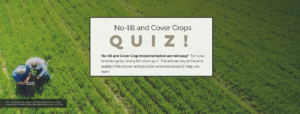
- NJRCD made participants aware of the availability of support from project leaders and instructors as needed and supplies participants with additional copies of the manual, as needed.
- Participants in the program were encouraged during the webinars to join numerous Facebook groups that achieved similar learning objectives.
120 ASPs receive quarterly reminders throughout the project to track farmer interactions for inclusion on worksheets assessing primary action outcomes. Ongoing to September 2021
120
81
September 30, 2021
Completed
November 15, 2021
81 ASPs enrolled in the program were emailed reminders every 4-6 months to complete an online form assessing primary action outcomes. Participants recorded activities using this simple online form:
https://www.northjerseyrcd.org/sare-metrics
Participants who did not respond to mass email requests also personally emailed and often called.
10 participants will receive additional one-on-one support/consultations with the project leader, as needed. 2020-2021
10
September 30, 2021
Completed
October 21, 2021
North Jersey RC&D offered participants in the course the option of 1:1 consultation with project instructors. However, participants did not use this service. As a result of COVID, many ASPs expressed that they have greatly reduced educational and technical assistance activities with farmers.
Participants did request copies of the No-till and Cover Crop Implementation Guide for their colleagues, staff, and farmers. North Jersey RC&D mailed multiple copies of the book to 40 ASPs and provided an additional 30+ copies to attendees of the in-person workshop. An additional 50 copies were mailed to Stroud Water Research Center as a resource to farmers attending PA No-till Farming Events. These books serve as an enduring educational resource for the ASP and farming communities.
VERIFICATION OF ACTIONS AND CHANGES
100 participants respond to an online survey assessing learning outcomes. Winter 2020
100
48
December 31, 2020
Completed
December 18, 2020
48 program participants completed a short online survey and post-assessment.
The post-assessment questions and corresponding results can be viewed here: Post-Assessment. Participants scored much higher on the post-assessment compared to the pre-assessment. On average, applicants correctly answered 72% of the questions. The median number of correct responses was 10/14. This represents a 44% improvement compared to the pre-assessment. Furthermore, on the pre-assessment, over half of the participants answered less than 40% of questions correctly, highlighting a substantial knowledge gap; on the post-assessment, over half of the participants answered more than 72% of questions correctly.
In addition to assessing the program objectives through a pre-and post-assessment, NJRCD administered a survey to program participants focused on their opinions of the educational program. The results can be viewed here: Survey Results. The main takeaways from the survey were as follows:
- The majority of participants ranked the course manual, webinars, and instructors as excellent.
- The majority of participants rated the reading assignments from the course manual, video watching assignments, instructor's lectures, and breakout discussions as very useful.
- The majority of participants felt significantly more prepared to discuss preparing for no-till and more prepared to discuss cover crop selection, cover crop application, and cover crop termination with farmers.
- 95% of participants indicated that they would recommend this course to a colleague.
- Comments indicated that most participants enjoyed the course. The most significant complaint was that the course manual contained distracting typos.
100 participants complete and return worksheets assessing primary action outcomes actions, specifically action taken assisting and educating farmers. Summer 2021
100
51
November 15, 2021
Completed
November 15, 2021
North Jersey RC&D made contact with 51 workshop participants (63% of all workshop participants) to evaluate actions they had taken in assisting and educating farmers. In order to improve the assessment of action-outcome, North Jersey RC&D staff sent personalized emails and called participants who did not complete the online form for which we had a phone number on record. However, 14 participants did not have valid contact information, either because they changed careers or retired. 16 participants did not respond to any follow-up requests for more information.
For more information about the action taken by program participants following the education program see the Performance Target Section below.
100 participants who complete all verification steps (response to surveys and submission of completed worksheets) receive a course completion certificate. Summer 2021
43
100
November 19, 2021
Completed
November 15, 2021
NJRCD emailed digital course completion certificates to all participants who completed all online workshops and metrics verification.
Milestone Activities and Participation Summary
Educational activities and events conducted by the project team:
Participants in the project’s educational activities:
Learning Outcomes
METHODS USED TO COLLECT LEARNING OUTCOME DATA:
Improvement in knowledge and skills was verified by comparing pre-and post-assessments. 50 Program Participants completed both the pre-and post-assessments. Their scores were compared to determine changes in knowledge, attitudes, and skills. All 50 participants scored higher on the post-assessment compared to the pre-assessment.
The pre-assessment is located here: https://forms.gle/6Y2AFiyyfQwQs5kx6
The post-assessment is located here: https://forms.gle/Lus33V2t54ZPgaa1A
Changes in knowledge and attitudes were further verified by asking participants if they felt more prepared to discuss various no-till and cover crop implementation topics after completing the course. 90% or more of program participants stated they were more prepared to talk with farmers about the following topics after taking this course:
- How to Prepare for No-till
- No-till and Nutrient Management
- No-till Equipment
- No-till Troubleshooting
- Cover Crop Selection
- Cover Crop Application
- Cover Crop Termination
Furthermore, participants in the in-person 2021 field workshop were asked how participation in the workshop impacted their knowledge. All participants who completed assessments (22 individuals) reported that they were either somewhat more knowledgeable, more knowledgeable, or substantially more knowledgeable about the following topics:
(1) Engaging Farmers about Soil Health, (2) No-till and Cover Crop Equipment, and (3) Substantially More Knowledgeable.
Performance Target Outcomes
Performance Target Outcomes - Service Providers
Target #1
100
100 agricultural service providers (ASPs) who increase knowledge related to specific techniques and challenges associated with planting cover crops and adopting no-till in commodity crop systems, will provide comprehensive technical assistance to 600 farmers, operating 60,000 acres of cropland, regarding transitioning to no-till and implementing cover crops.
600
60,000 acres of cropland
32
210
31148 acres of cropland
- 5 Curricula, factsheets and other educational tools
- 5 Consultations
- 1 Published press articles/newsletters
- 21 Webinars/talks/presentations
- 1 Workshops/field days
PERFORMANCE TARGET VERIFICATION METHODS:
81 ASPs received email reminders to complete an online form assessing primary action outcomes. Participants were asked to complete the form approximately every 6-months. The form asked participants to summarize interactions with farmers and other activities designed to educate farmers and/or agricultural service providers that relied on information from the course. In total, 47 participants completed the online form.
BARRIERS ENCOUNTERED
- Enrollment in the program was lower than anticipated as a result of moving the program from in-person to online. Participation in the program was lower than expected; it is hypothesized that 6-months into the COVID pandemic, many ASPs were "burnt-out" on zoom-based educational opportunities. The opportunity to socialize and interact with equipment was greatly reduced in the zoom setting which decreased interest in the program. Ultimately, this significantly hindered the ability to meet performance metrics.
- Some participants did not conduct 1:1 outreach with farmers. The outreach of many ASPs to farmers was significantly reduced during COVID. In the performance metrics tracking, 15 participants indicated that they did little to no farmer outreach during the 1.5 years after course completion, either because of organization rules or job descriptions changes.
- Some participants changed careers and could not be contacted. 14 program participants changed careers and could not be contacted at some point during the 1.5-year period after course completion.
- Some participants did not respond to emails or phone calls asking them to summarize project impacts. 18 Participants could not be contacted by NJRCD staff after course completion.
UNEXPECTED SUCCESSES
- Course Book/Manual is a popular tool to learn about no-till and cover crops among farmers and new agricultural service providers. 9 participants have requested additional copies of the course manual to share with colleagues/farmers; NJRCD has provided these participants with 16 course manuals. In addition, larger agencies, including the PA No-till Alliance, Rosetree Consulting, and Stroud Water Research requested over 100 copies of the books to distribute to farmers. NJRCD anticipates publishing and widely distributing the course manual.
VERIFIED CHANGES IN KNOWLEDGE, ATTITUDES, AND SKILLS
48 program participants completed the form assessing primary action outcomes. Participants indicated that they used information from the manual and/or training to provide technical assistance to 210 farmers, farming on 31,148 acres. In addition, ASPs used information in the training in 25 webinars/meetings reaching an estimated 1756 farmers and/or agricultural service provides.
Performance Target Outcomes - Farmers
Additional Project Outcomes
As North Jersey RC&D researched no-till and cover crop implementation, it became apparent that a major impediment to greater soil health practice implementation was the lack of proper equipment and lack of quality, regionally relevant research. North Jersey RC&D applied for, as received an NRCS CIG On-farm Research Trial Soil Health Demonstration: Innovative Strategies for Cover Crop Termination: Demonstrating the Full Agronomic and Economic Value of Cover Crops to Accelerate Soil Health Management System Adoption. The grant funds equipment retrofits for farmers who try "Planting Green", "Roller-Crimping" or "Grazing Cover Crop" as well as in-depth soil health and economic analysis. Funding and research from the grant will be used to inform Chapter 3: "Advanced Soil Health Practices" in the course manual: "A Practical Guide to No-till and Cover Crop in the Mid-Atlantic".
QUOTES FROM POST ASSESSMENT SURVEY:
- " I thought this was one of the best, and most useful trainings I've ever taken. The manual, aside from a few typos, is a perfect guide. I really appreciated the reading assignments, I got a lot out of them." - NRCS Soil Conservationists
- "Really enjoyed this course! Covered a lot of information not usually covered in other trainings. Very practical and can be directly used with farmers out in the field." - NRCS Soil Conservationists
-
"GREAT course! The format was exceptionally engaging, the speakers made the material very accessible and the tone of the class was friendly, supportive, and fun. The website was easy to navigate and provides great additional info with videos and the list of additional resources." - Agricultural Conservation Specialist from a Non-Profit
-
"Although this was a different setting for trainings, I felt that each was well prepared for and that the online version was smooth. I look forward to other training opportunities from RC&D" - Seed Dealer
-
"While I learned plenty through experience over the a couple decades, this was the first book that was the perfect combination of rich technical details delivered in an easy to understand format." - Agricultural Conservation Specialist from a Non-Profit
- "I really enjoyed the book and the practices it shared and outlined. The knowledge was presented in an easy-to-digest format and made even imposing farm machine choices clear and actionable." - University Extension Agent
-
"We visit with a bunch of farmers throughout the year and while we don’t necessarily give recommendations like an agronomist would, the course you put on has made me a lot more confident in talking with producers and trying to give some advice or point them in the right direction. I feel a ton more confident with the process of cover crops and with the issues or hesitations that may be keeping them from switching to a no-till or cover crop system." -- County Conservation District Agricultural Leader
- "I appreciated the focus on not only cover crop growth and benefits but also the equipment setup and economics. It was a well-rounded program. The use of cover crops in a no-till system is constantly evolving. From big biomass covers to 'thin planting green' covers, innovation in this space will continue to need outreach & trainings to share these changes." - Certified Crop Consultant
- "The guide was especially helpful for me with the equipment as that is not my strong point. I showed it to a colleague at NRCS and she said that was the best and most comprehensive guide she has seen." -- Conservation District Staff
Information Products
- A Practical Guide to No-till and Cover Crops in the Mid-Atlantic (Book/Handbook)
